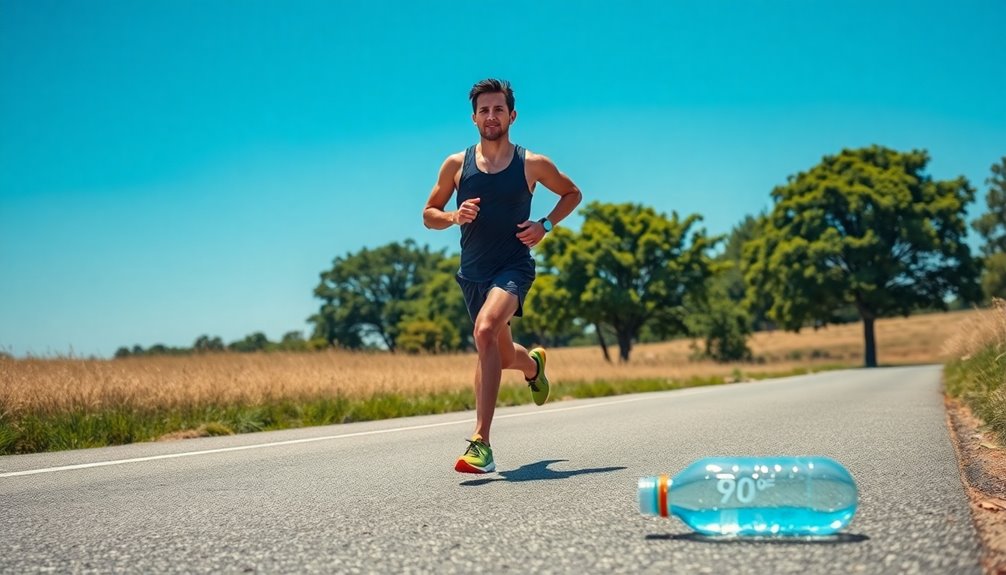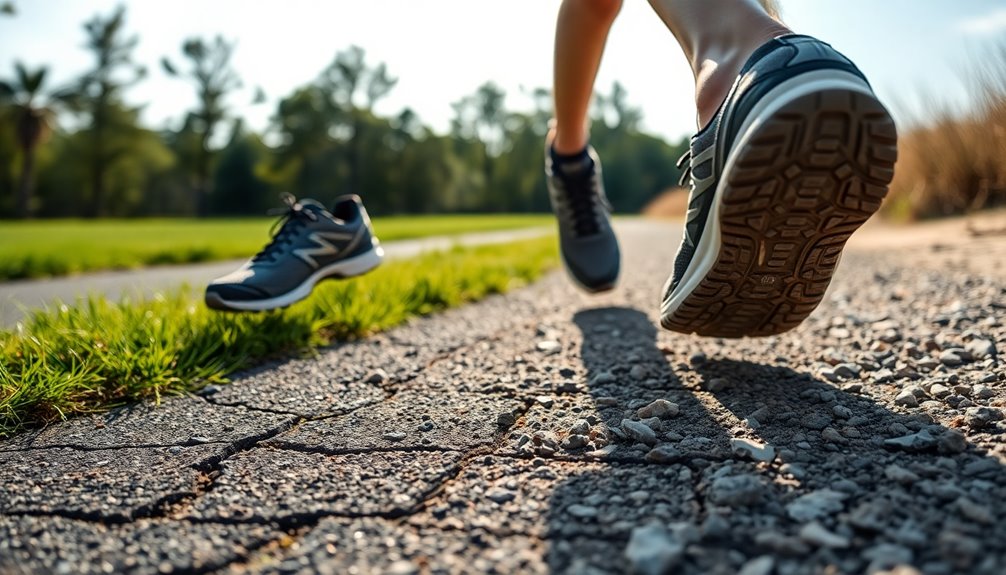Environmental factors can greatly impact your running performance. High temperatures might add time to your race, while humidity can make runs feel tougher and hinder your body's cooling ability. Wind affects your pace, with headwinds slowing you down and tailwinds boosting performance. Altitude can limit oxygen, leading to diminished endurance. Finally, the type of surface you run on can increase injury risks. Want to discover how to navigate these challenges? There's more important information ahead!
Key Takeaways
- High temperatures can increase marathon times by an average of 8 minutes, leading to dehydration and heat stress.
- Humidity impairs sweat evaporation, resulting in slower race times and increased perceived exertion.
- Headwinds can slow runners down by 3 to 4 seconds per mile, while tailwinds can enhance performance.
- Running at high altitudes reduces oxygen availability, negatively affecting performance, but acclimatization can improve outcomes at sea level.
- The type of running surface significantly influences injury risk, with turf associated with higher rates of musculoskeletal injuries compared to grass.
The Impact of Temperature on Performance

When temperatures rise, your running performance can take a significant hit. High temperatures can add an average of 8 minutes to your marathon race times, especially affecting younger and middle-aged runners.
You might face dehydration and heat stress, which are common issues in hot environmental conditions. Managing your hydration is essential to help maintain your performance levels.
Extreme heat can impair your thermoregulation, leading to serious risks like heat stroke. As an endurance athlete, you need to adapt to these conditions through acclimatization, enhancing your heart rate and ventilation. Additionally, regular exercise can significantly lower health risks associated with extreme temperature exposure.
How Humidity Affects Your Runs

Heat isn't the only environmental factor that can impact your running performance; humidity plays a significant role as well. High humidity levels can lead to slower race times, particularly in marathons, as they hinder your body's ability to cool itself through sweat evaporation.
This can result in overheating, decreased endurance, and even heat stroke during your runs. Research shows that higher humidity exacerbates perceived exertion, making your runs feel more challenging.
Male marathoners may tolerate humidity better than females, but both sexes should adjust pacing strategies accordingly. Understanding how humidity affects your athletic performance can help you optimize hydration and enhance your overall running experience. Additionally, recognizing the importance of hydration can further improve your performance in humid conditions.
Always consider these environmental factors when planning your training or race day strategy.
The Role of Wind in Running Efficiency

While you mightn't always notice it, wind can greatly influence your running efficiency. Headwinds can markedly increase your race times, adding an average of 3 to 4 seconds per mile for every mile per hour of wind speed. This performance degradation is especially pronounced in younger male runners, who struggle more in windy conditions.
Conversely, tailwinds can boost your performance by making it easier to maintain your pace, offering a helpful push.
It's essential to take into account wind direction and speed when planning your race strategy, as strong headwinds may require you to adjust your pacing and energy expenditure. Additionally, indoor water parks provide an excellent environment for training during adverse weather conditions, allowing runners to maintain their fitness year-round.
Altitude and Its Effects on Endurance

As you ascend to higher altitudes, the thinner air can make your runs feel markedly tougher due to decreased oxygen levels. This reduction complicates oxygen uptake, leading to quicker fatigue for endurance athletes. Performance often declines considerably above 6,500 feet, but the body can adapt.
| Altitude (feet) | Oxygen Availability | Endurance Impact |
|---|---|---|
| 0 | 100% | Optimal |
| 3,000 | 90% | Minor decline |
| 6,500 | 75% | Noticeable decline |
| 10,000 | 60% | Major fatigue |
| 14,000 | 50% | Severe fatigue |
Training at altitude promotes adaptations that enhance oxygen utilization, improving your endurance performance when you return to sea level. Embrace the challenge; acclimating can lead to better race times! Additionally, maintaining a high vibrational energy can help you push through the physical challenges of altitude training.
Surface Types and Injury Risks

Running at different altitudes can challenge your body in unique ways, but the surface you run on also plays a significant role in your overall performance and injury risk.
The type of surface you choose can drastically affect your chances of sustaining injuries like ACL and PCL tears.
- Turf surfaces are linked to higher rates of musculoskeletal injuries.
- PCL tears occur nearly three times more often on turf than on grass.
- Lower-level athletes are 1.6 times more likely to suffer ACL tears on turf.
- Grass fields can help reduce these injury risks.
Choosing the right surface is essential for your safety and performance, so consider opting for grass to lower your chances of injury while running. Additionally, maintaining a clean and safe environment when running, similar to wood stove operation safety, can further enhance your overall performance.
Frequently Asked Questions
What Is the Environmental Impact of Running?
Running has a noticeable environmental impact. You mightn't realize, but the manufacturing and transportation of your shoes and gear consume significant energy and resources.
Plus, if you leave trash during races, it harms the environment, especially in rural areas. Traveling for races also increases your carbon footprint.
To lessen your impact, consider local events, recycle old gear, and always be mindful of waste management practices while you run.
What Are the Environmental Factors That Affect Exercise?
Exercise in varying environments is like dancing on different stages; each setting changes the rhythm. Factors like temperature, humidity, and altitude play vital roles in your performance.
High heat can drain your energy faster than a leaky faucet, while humidity might make you feel like you're running through molasses.
Altitude can leave you gasping for breath, affecting your stamina. Understanding these elements helps you train smarter and stay safe while working out.
What Are the Environmental Factors Affecting Athletic Performance?
Environmental factors like weather, altitude, and playing surface greatly affect athletic performance.
You may find that high temperatures or humidity can slow you down, while competing at high altitudes might leave you gasping for breath due to lower oxygen levels.
Additionally, injuries are more common on turf than grass.
Finally, poor air quality can hinder your breathing and overall stamina, making it essential to take these factors into account before any competition.
What Environmental Factors May Affect Performance?
Imagine running a marathon in a sauna—high temperatures can add about 8 minutes to your finish time.
Wind can feel like an invisible opponent, slowing you down more than you'd expect.
Humidity creeps in, making you sweat more, especially if you're in your 40s or 50s.
If you're racing at altitude, your lungs might struggle for oxygen, increasing fatigue.
Ultimately, the surface you run on can impact your risk of injury considerably.
Conclusion
To summarize, understanding how environmental factors affect your running can help you tailor your workouts for better performance and safety. Just like a flower needs the right conditions to bloom, you too can thrive by adapting to temperature, humidity, wind, altitude, and surface types. By tuning into these elements, you'll not only enhance your runs but also enjoy them more. So, the next time you lace up, remember to embrace the environment—it's your ally in reaching new heights!









